Assessment of Land Resources Potentials for Orientation of Agriculture Land Use in Ham Thuan Bac district, Binh Thuan province
Land resources potential assessment is a valuable method for
orienting land use planning in the world as well as in Vietnam. This
study aimed to (1) assess land suitability and (2) orient the effective
use of agricultural land in the study area. Results indicated that Ham
Thuan Bac had 107 land mapping units (LMUs) with 11 main landuse types (LUTs) such as rice, cassava, vegetables, dragon fruit, and
other trees. Agricultural land with high (S1) and moderate suitability
(S2) for most LUTs was small; however, marginal (S3) and not
suitability (N) lands were quite large. Results of land suitability
evaluation on current land use showed that land area of annual crops
was mainly found at the S3 suitability level, specifically for the rice
area, 67.75% was marginally suitable and 23.29% of the area was
unsuitable; In terms of perennial trees, except for dragon fruits which
were mainly cultivated at the S2 suitability level (78.28%), the others
such as cashew and other fruit trees were S3 and N levels. Based on
land suitability classification, for mainstay LUTs, we proposed to
keep 8550.0ha with S1, S2, and a part of S3 area to be irrigated for
cultivating rice; 9071.7ha of dragon fruit land including 694.67ha of
S1 and 8377.03ha of S2 land; only cultivate annual crops, fruit trees
and grazing grass on the land with suitable levels from S1 to S3 of
the current status; and the remaining areas of S3 and N levels for rice
and areas of S2, S3, or N levels for dragon fruit would be converted
to lands for annual crops, fruit trees, or grass for livestock.
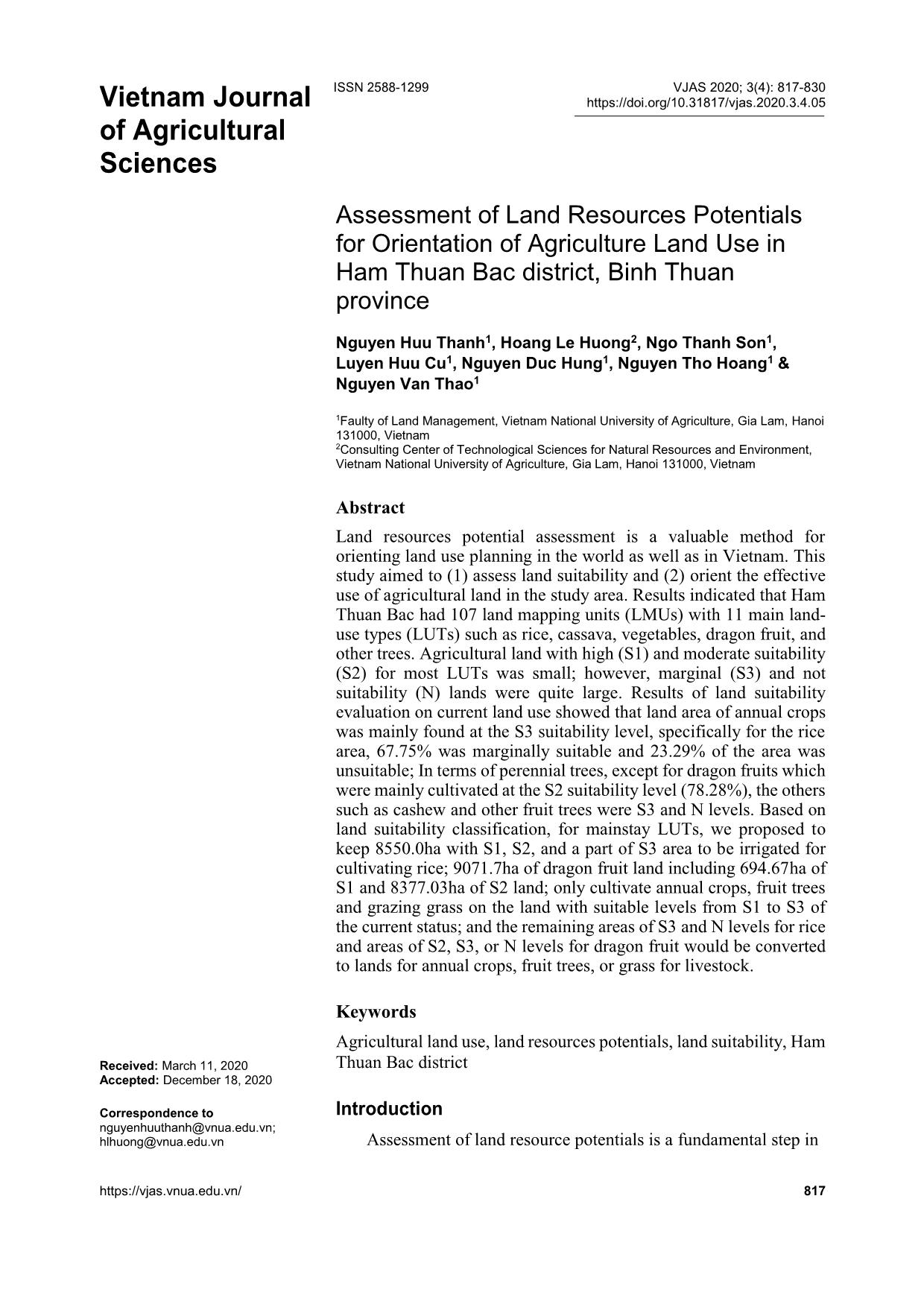
Trang 1
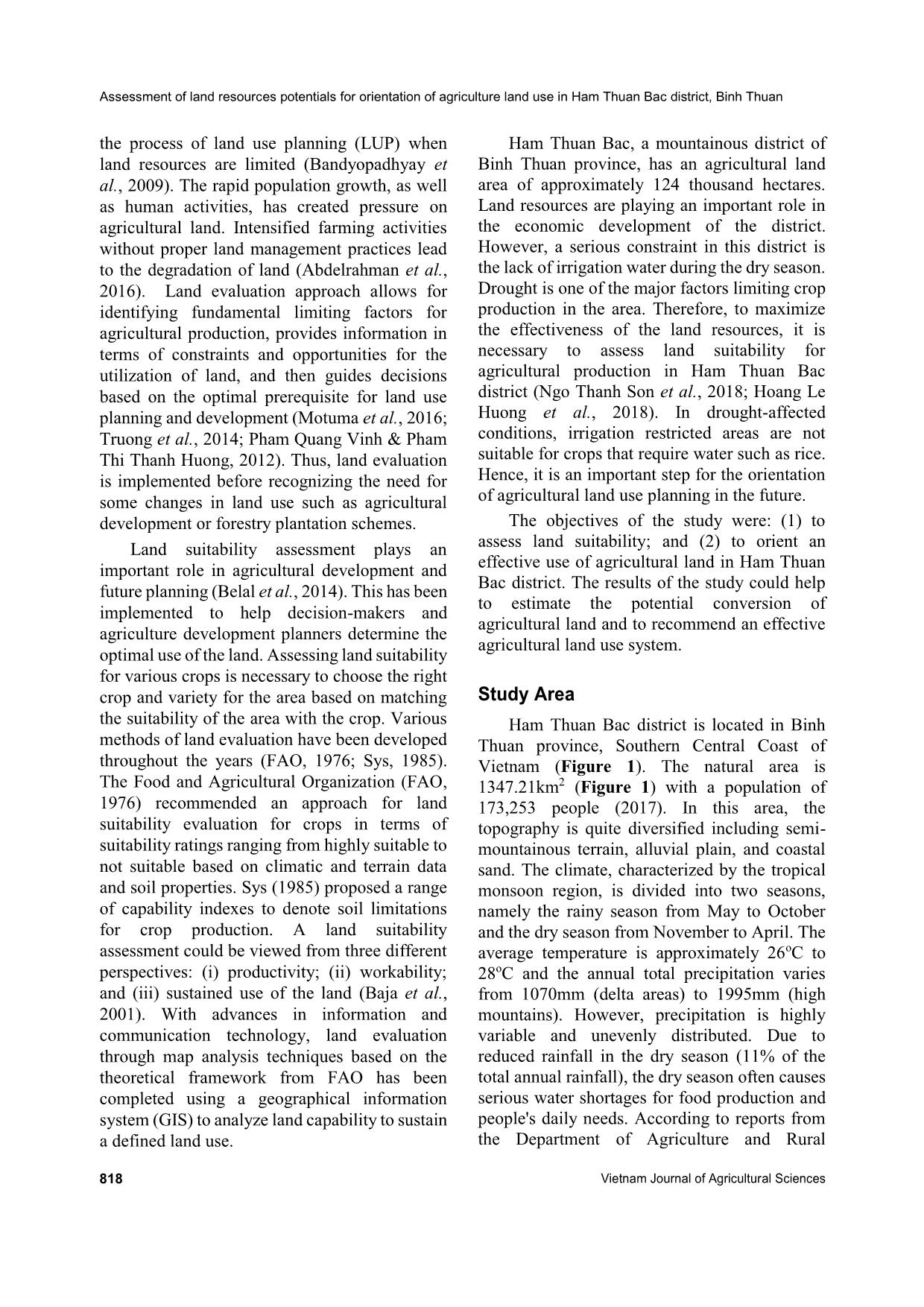
Trang 2
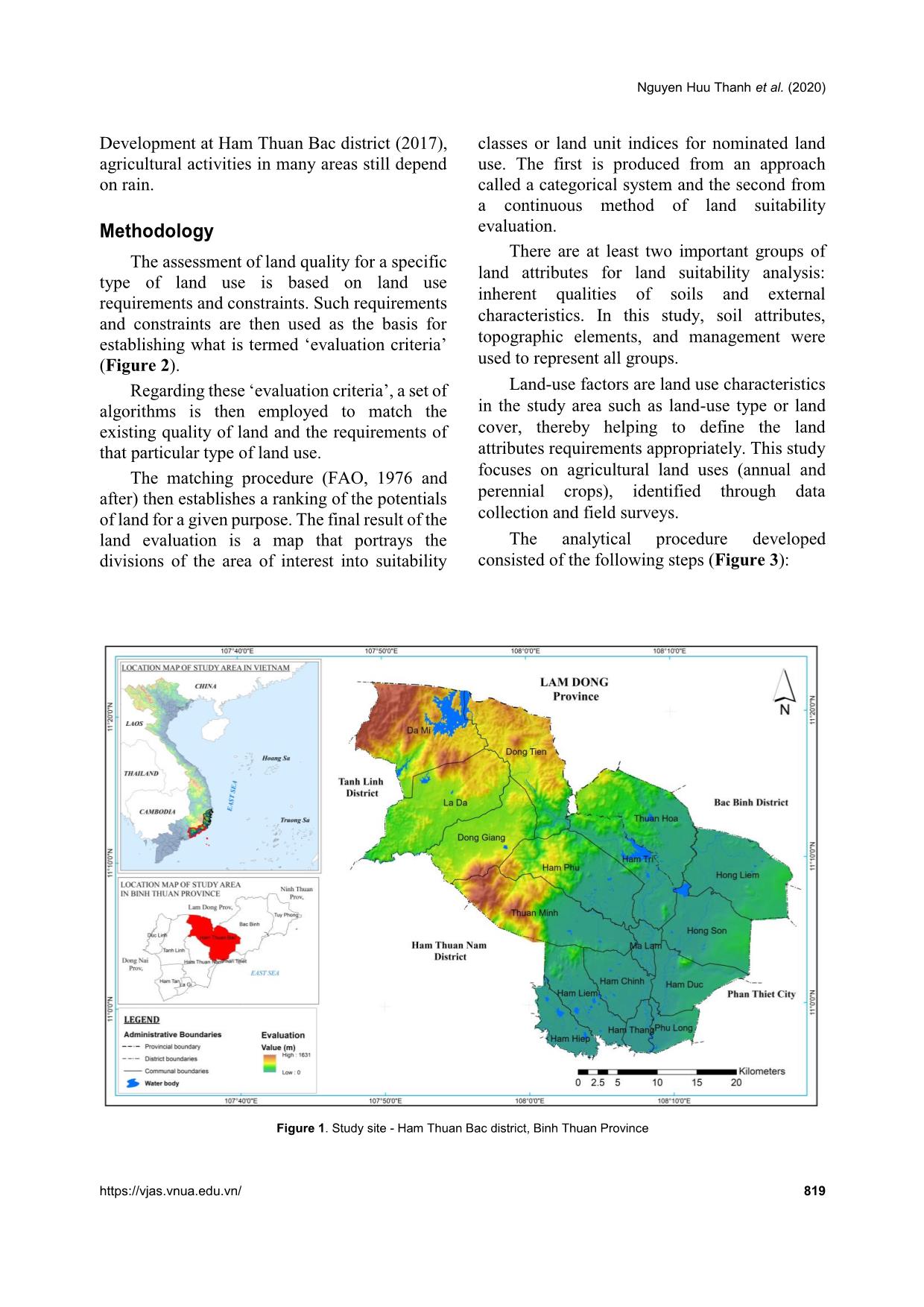
Trang 3
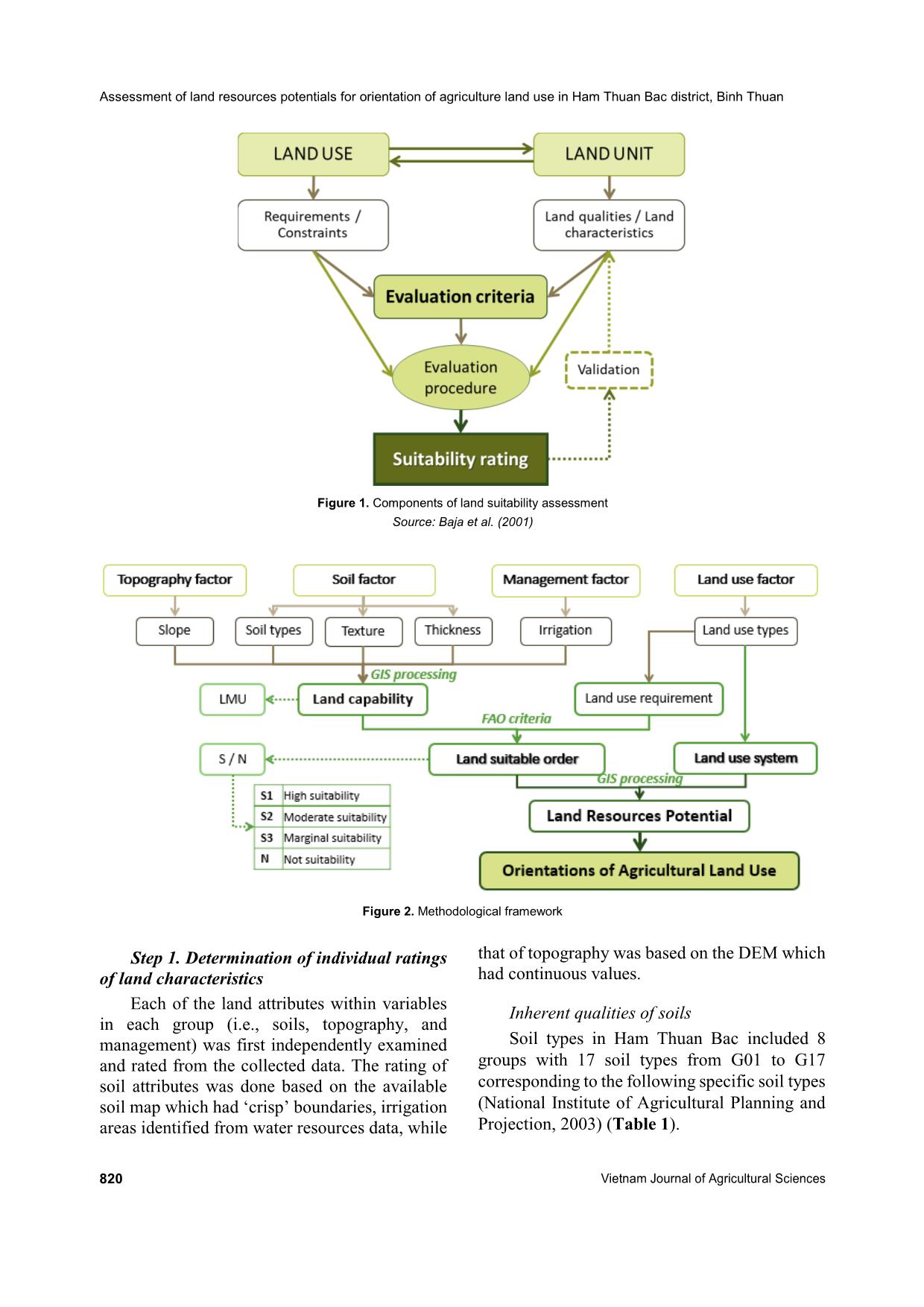
Trang 4
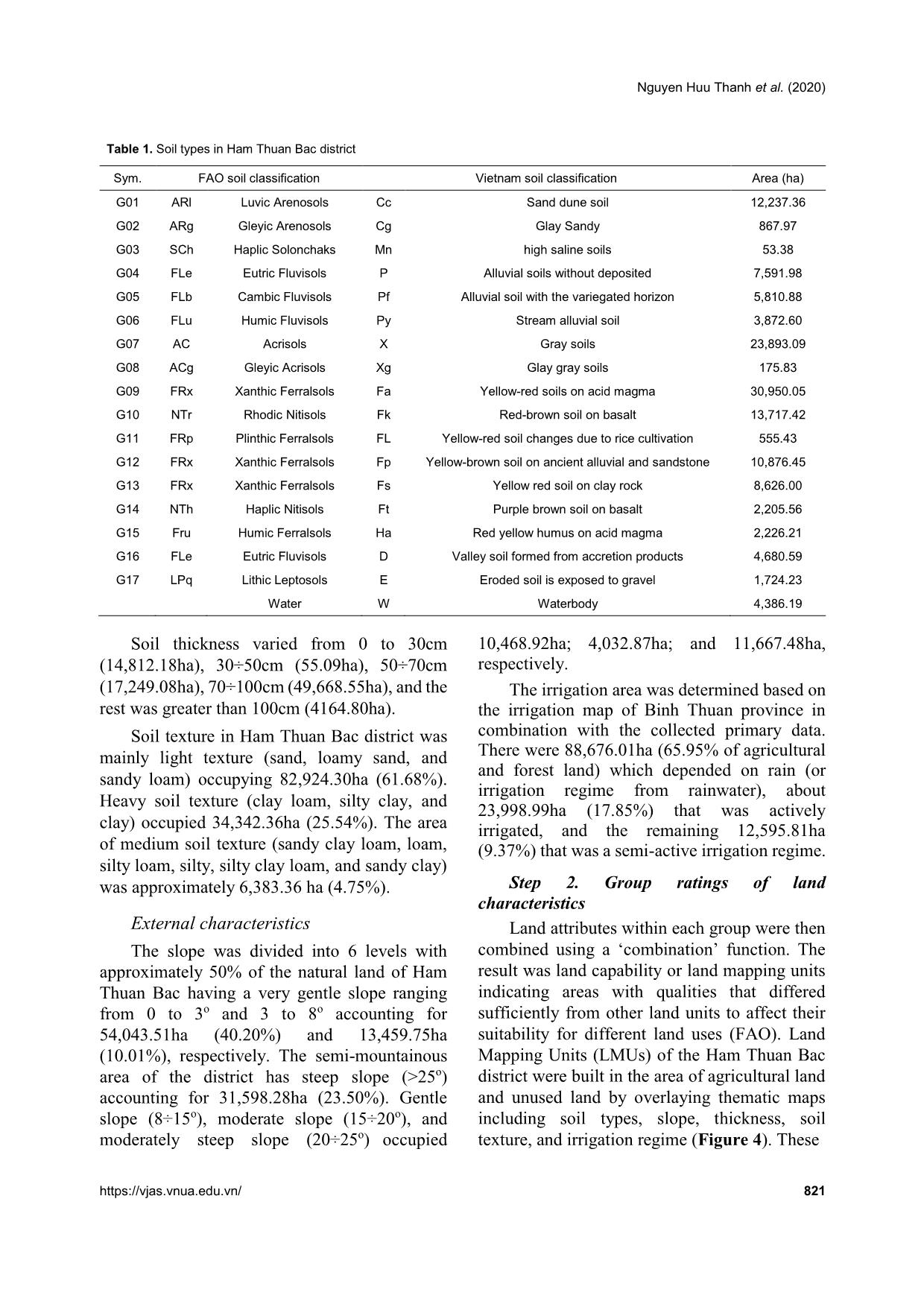
Trang 5
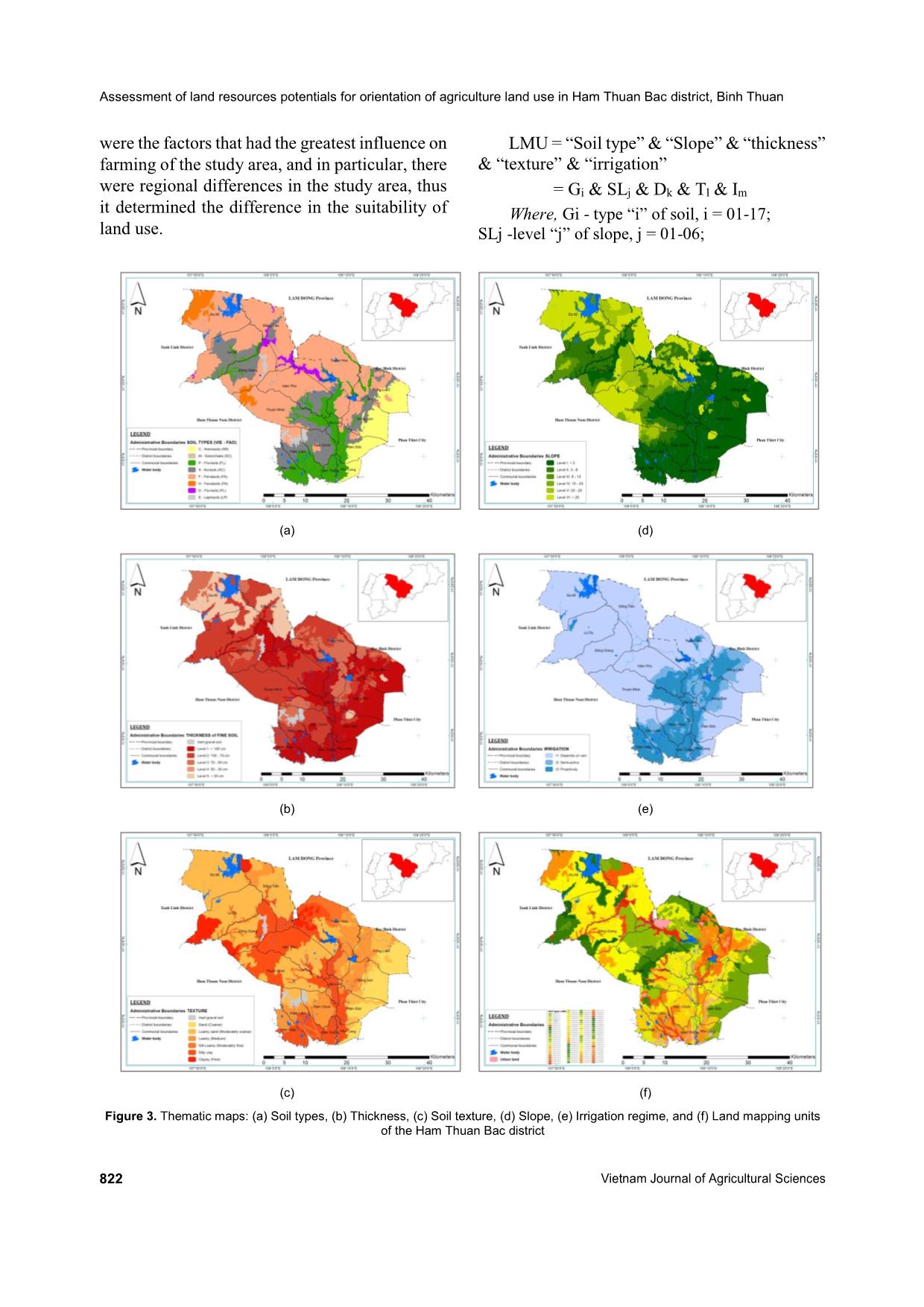
Trang 6
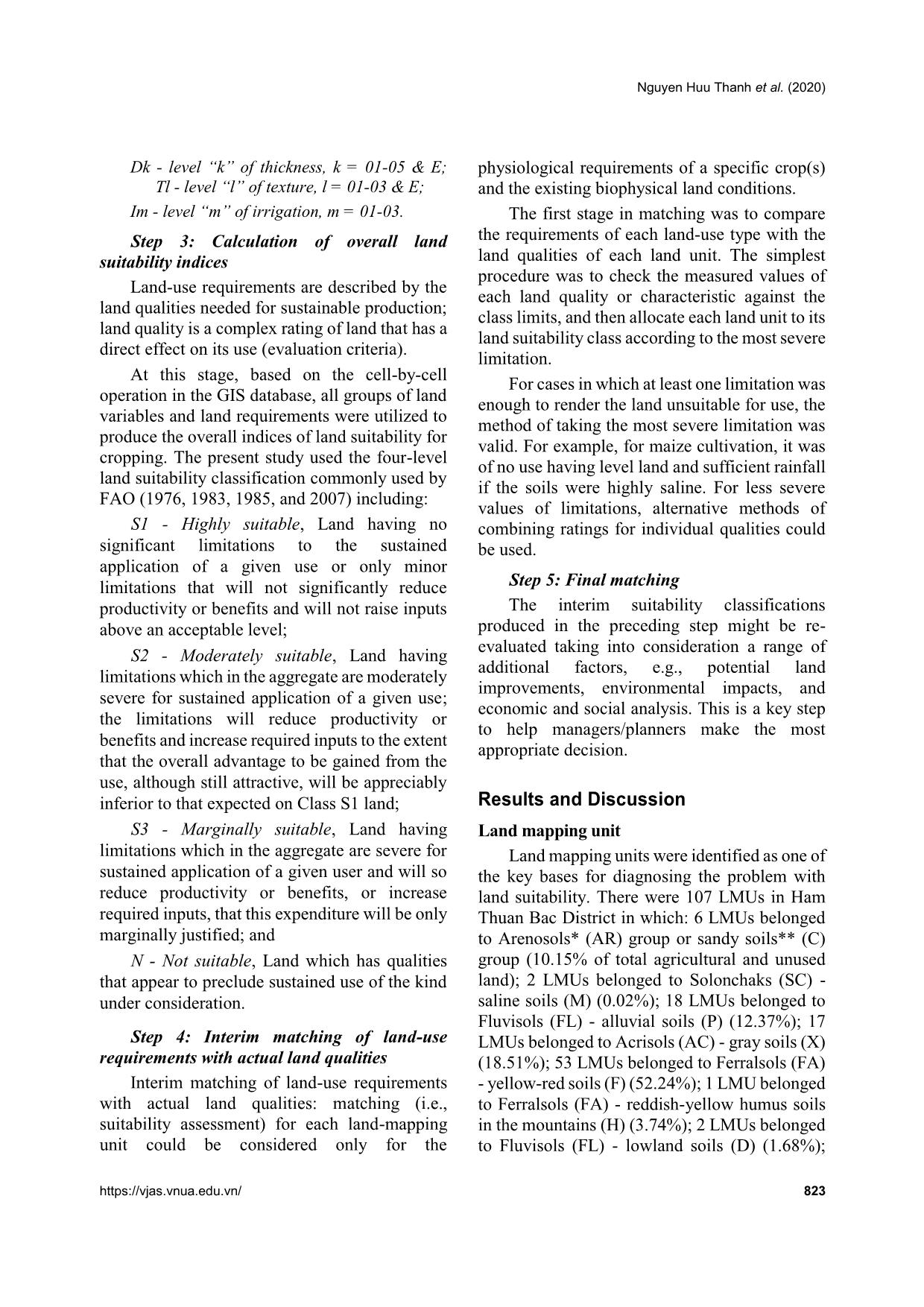
Trang 7
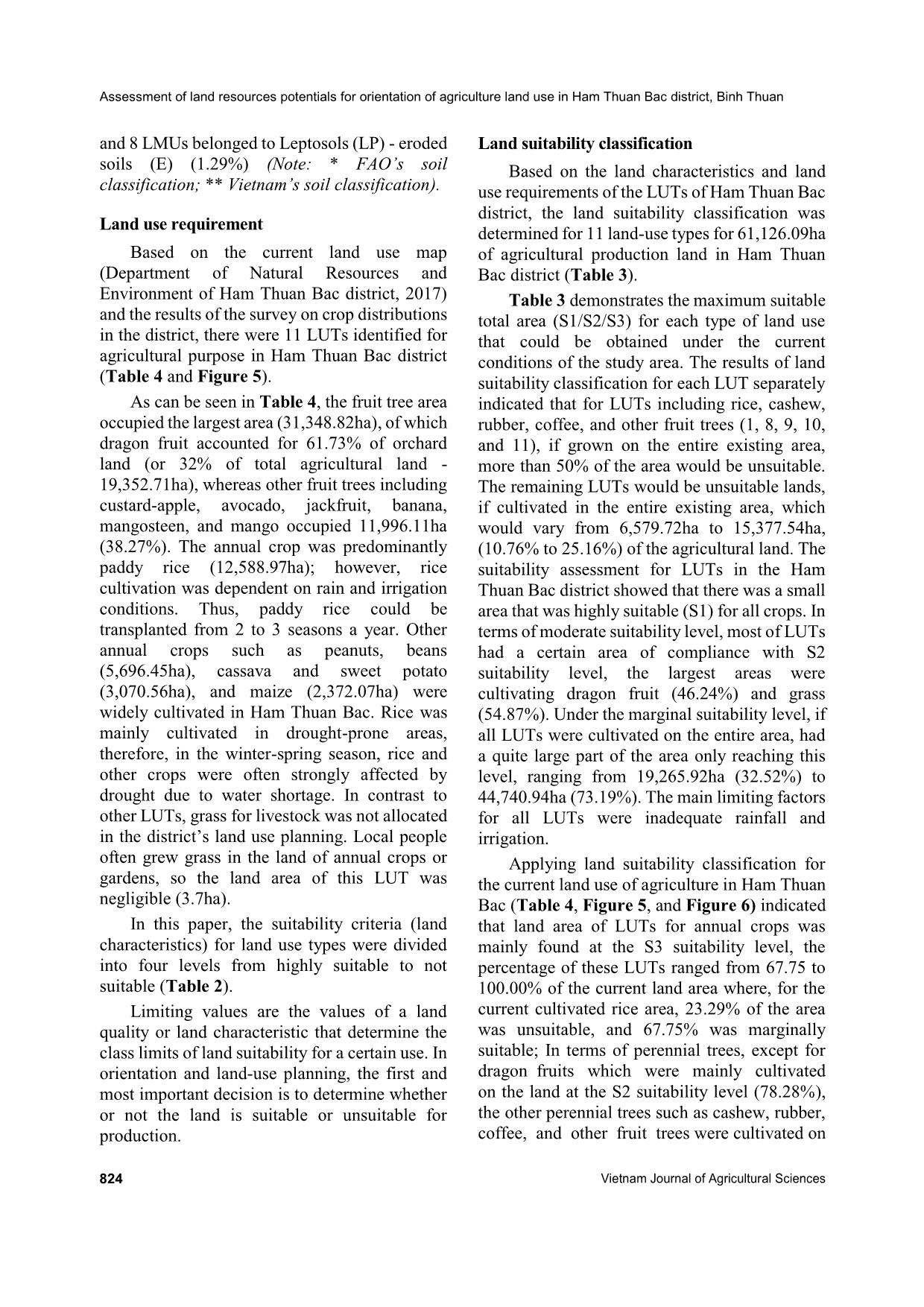
Trang 8
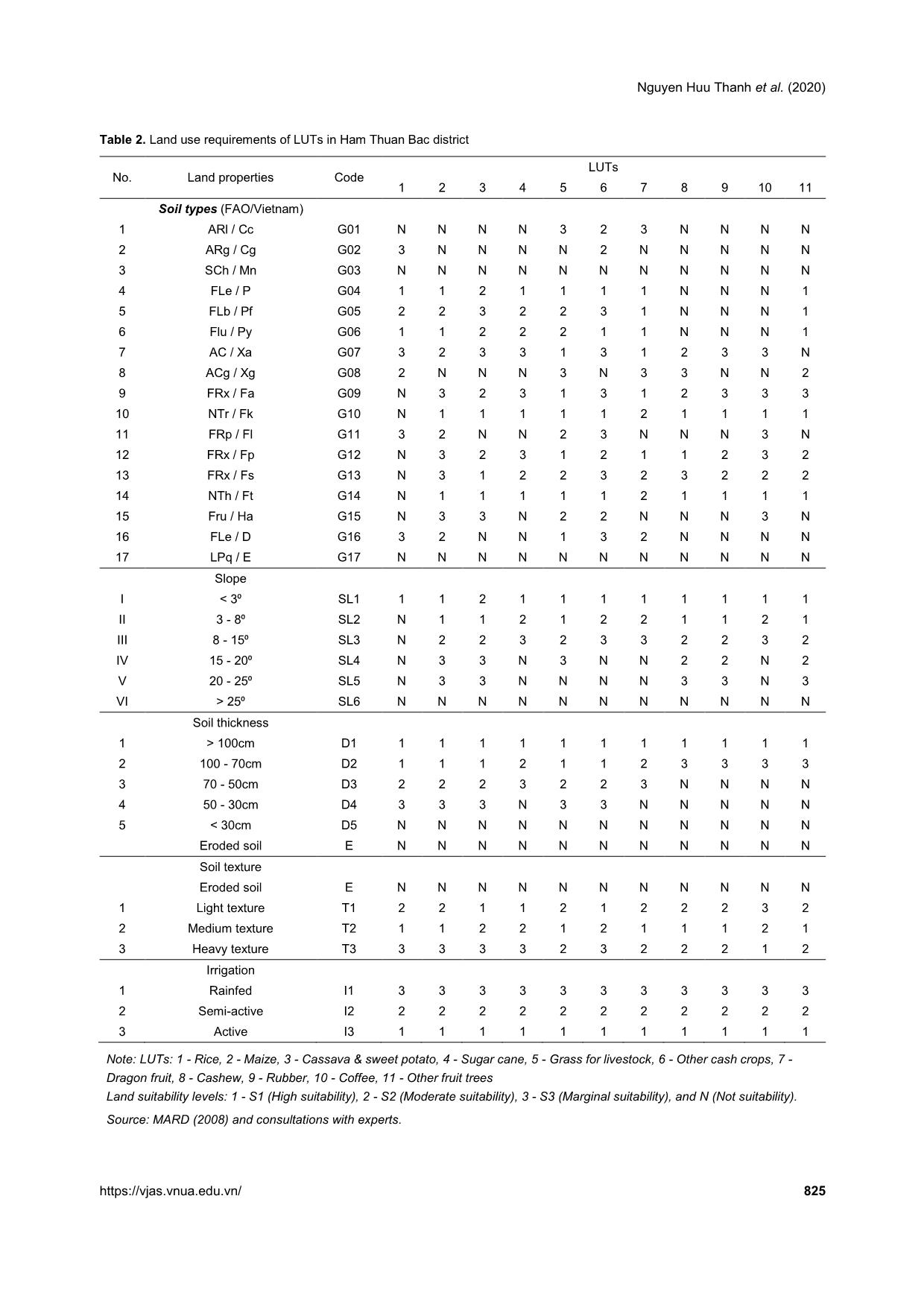
Trang 9
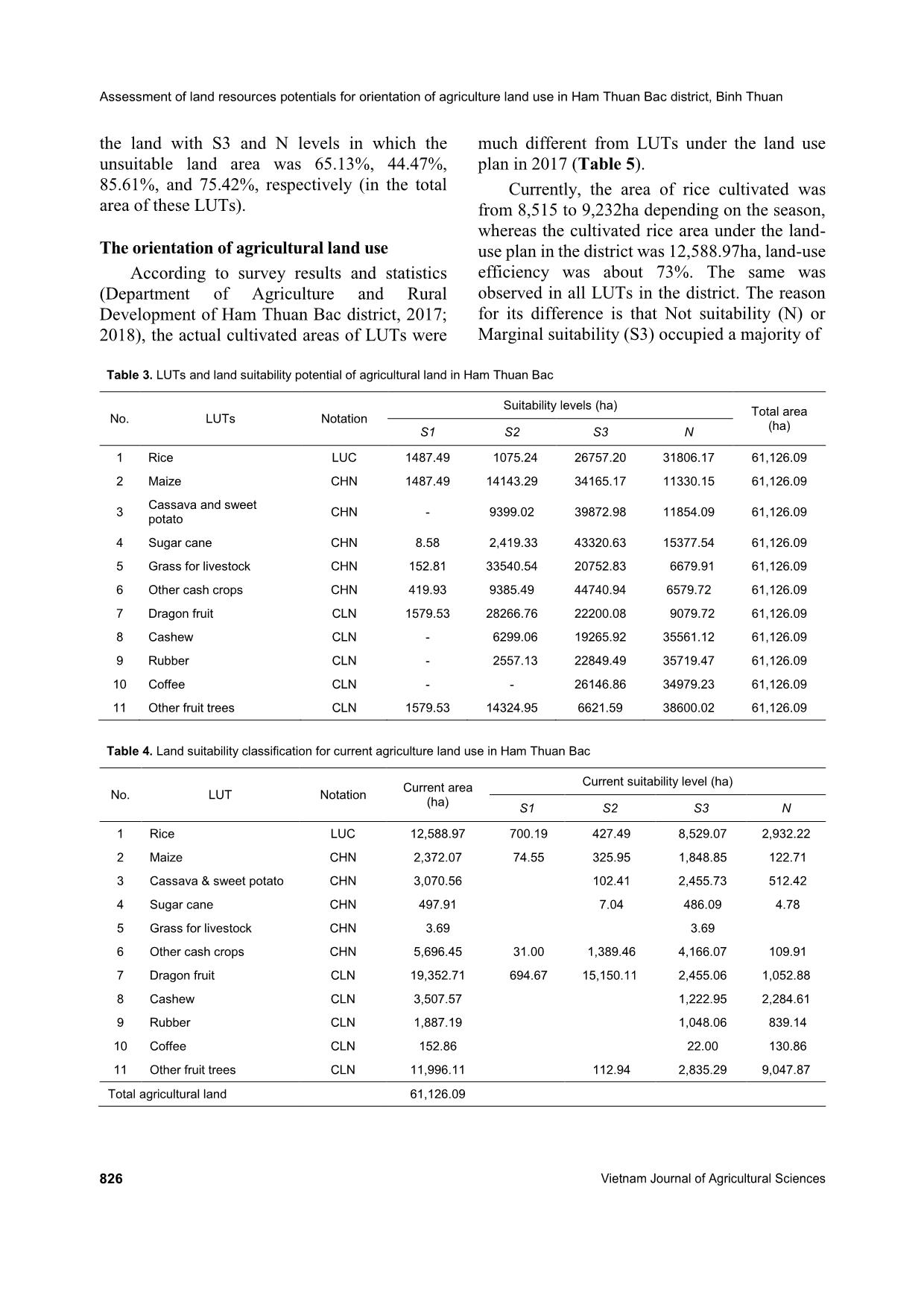
Trang 10
Tải về để xem bản đầy đủ
Tóm tắt nội dung tài liệu: Assessment of Land Resources Potentials for Orientation of Agriculture Land Use in Ham Thuan Bac district, Binh Thuan province
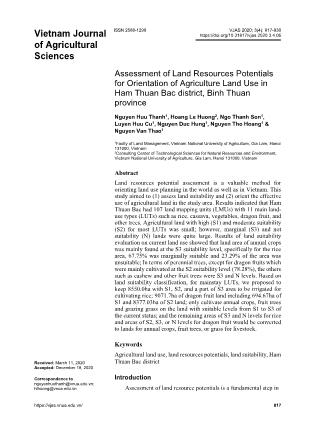
1 Soil types (FAO/Vietnam) 1 ARl / Cc G01 N N N N 3 2 3 N N N N 2 ARg / Cg G02 3 N N N N 2 N N N N N 3 SCh / Mn G03 N N N N N N N N N N N 4 FLe / P G04 1 1 2 1 1 1 1 N N N 1 5 FLb / Pf G05 2 2 3 2 2 3 1 N N N 1 6 Flu / Py G06 1 1 2 2 2 1 1 N N N 1 7 AC / Xa G07 3 2 3 3 1 3 1 2 3 3 N 8 ACg / Xg G08 2 N N N 3 N 3 3 N N 2 9 FRx / Fa G09 N 3 2 3 1 3 1 2 3 3 3 10 NTr / Fk G10 N 1 1 1 1 1 2 1 1 1 1 11 FRp / Fl G11 3 2 N N 2 3 N N N 3 N 12 FRx / Fp G12 N 3 2 3 1 2 1 1 2 3 2 13 FRx / Fs G13 N 3 1 2 2 3 2 3 2 2 2 14 NTh / Ft G14 N 1 1 1 1 1 2 1 1 1 1 15 Fru / Ha G15 N 3 3 N 2 2 N N N 3 N 16 FLe / D G16 3 2 N N 1 3 2 N N N N 17 LPq / E G17 N N N N N N N N N N N Slope I < 3⁰ SL1 1 1 2 1 1 1 1 1 1 1 1 II 3 - 8⁰ SL2 N 1 1 2 1 2 2 1 1 2 1 III 8 - 15⁰ SL3 N 2 2 3 2 3 3 2 2 3 2 IV 15 - 20⁰ SL4 N 3 3 N 3 N N 2 2 N 2 V 20 - 25⁰ SL5 N 3 3 N N N N 3 3 N 3 VI > 25⁰ SL6 N N N N N N N N N N N Soil thickness 1 > 100cm D1 1 1 1 1 1 1 1 1 1 1 1 2 100 - 70cm D2 1 1 1 2 1 1 2 3 3 3 3 3 70 - 50cm D3 2 2 2 3 2 2 3 N N N N 4 50 - 30cm D4 3 3 3 N 3 3 N N N N N 5 < 30cm D5 N N N N N N N N N N N Eroded soil E N N N N N N N N N N N Soil texture Eroded soil E N N N N N N N N N N N 1 Light texture T1 2 2 1 1 2 1 2 2 2 3 2 2 Medium texture T2 1 1 2 2 1 2 1 1 1 2 1 3 Heavy texture T3 3 3 3 3 2 3 2 2 2 1 2 Irrigation 1 Rainfed I1 3 3 3 3 3 3 3 3 3 3 3 2 Semi-active I2 2 2 2 2 2 2 2 2 2 2 2 3 Active I3 1 1 1 1 1 1 1 1 1 1 1 Note: LUTs: 1 - Rice, 2 - Maize, 3 - Cassava & sweet potato, 4 - Sugar cane, 5 - Grass for livestock, 6 - Other cash crops, 7 - Dragon fruit, 8 - Cashew, 9 - Rubber, 10 - Coffee, 11 - Other fruit trees Land suitability levels: 1 - S1 (High suitability), 2 - S2 (Moderate suitability), 3 - S3 (Marginal suitability), and N (Not suitability). Source: MARD (2008) and consultations with experts. Assessment of land resources potentials for orientation of agriculture land use in Ham Thuan Bac district, Binh Thuan 826 Vietnam Journal of Agricultural Sciences the land with S3 and N levels in which the unsuitable land area was 65.13%, 44.47%, 85.61%, and 75.42%, respectively (in the total area of these LUTs). The orientation of agricultural land use According to survey results and statistics (Department of Agriculture and Rural Development of Ham Thuan Bac district, 2017; 2018), the actual cultivated areas of LUTs were much different from LUTs under the land use plan in 2017 (Table 5). Currently, the area of rice cultivated was from 8,515 to 9,232ha depending on the season, whereas the cultivated rice area under the land- use plan in the district was 12,588.97ha, land-use efficiency was about 73%. The same was observed in all LUTs in the district. The reason for its difference is that Not suitability (N) or Marginal suitability (S3) occupied a majority of Table 3. LUTs and land suitability potential of agricultural land in Ham Thuan Bac No. LUTs Notation Suitability levels (ha) Total area (ha) S1 S2 S3 N 1 Rice LUC 1487.49 1075.24 26757.20 31806.17 61,126.09 2 Maize CHN 1487.49 14143.29 34165.17 11330.15 61,126.09 3 Cassava and sweet potato CHN - 9399.02 39872.98 11854.09 61,126.09 4 Sugar cane CHN 8.58 2,419.33 43320.63 15377.54 61,126.09 5 Grass for livestock CHN 152.81 33540.54 20752.83 6679.91 61,126.09 6 Other cash crops CHN 419.93 9385.49 44740.94 6579.72 61,126.09 7 Dragon fruit CLN 1579.53 28266.76 22200.08 9079.72 61,126.09 8 Cashew CLN - 6299.06 19265.92 35561.12 61,126.09 9 Rubber CLN - 2557.13 22849.49 35719.47 61,126.09 10 Coffee CLN - - 26146.86 34979.23 61,126.09 11 Other fruit trees CLN 1579.53 14324.95 6621.59 38600.02 61,126.09 Table 4. Land suitability classification for current agriculture land use in Ham Thuan Bac No. LUT Notation Current area (ha) Current suitability level (ha) S1 S2 S3 N 1 Rice LUC 12,588.97 700.19 427.49 8,529.07 2,932.22 2 Maize CHN 2,372.07 74.55 325.95 1,848.85 122.71 3 Cassava & sweet potato CHN 3,070.56 102.41 2,455.73 512.42 4 Sugar cane CHN 497.91 7.04 486.09 4.78 5 Grass for livestock CHN 3.69 3.69 6 Other cash crops CHN 5,696.45 31.00 1,389.46 4,166.07 109.91 7 Dragon fruit CLN 19,352.71 694.67 15,150.11 2,455.06 1,052.88 8 Cashew CLN 3,507.57 1,222.95 2,284.61 9 Rubber CLN 1,887.19 1,048.06 839.14 10 Coffee CLN 152.86 22.00 130.86 11 Other fruit trees CLN 11,996.11 112.94 2,835.29 9,047.87 Total agricultural land 61,126.09 Nguyen Huu Thanh et al. (2020) https://vjas.vnua.edu.vn/ 827 (a) (b) Figure 4. The current status map of agricultural land use in 2017 (a) and Map of land suitability classification for current agricultural land-use (b) of Ham Thuan Bac district Figure 5. Land adaptation map (or land potential) Assessment of land resources potentials for orientation of agriculture land use in Ham Thuan Bac district, Binh Thuan 828 Vietnam Journal of Agricultural Sciences Table 5. The actual cultivated area in 2017 and 2018 in Ham Thuan Bac district No. LUT Area (ha) Actual cultivated area (ha) Winter-spring Summer-autumn Autumn 16-17 17-18 2017 2018 2017 2018 1 Rice 12,588.97 8,515.0 8,545.0 9,171.0 9,000.0 9,323.0 9,079.0 2 Maize 2,372.07 75.5 68.0 528.0 619.0 1,327.0 1,526.0 3 Cassava and sweet potato 3,070.56 9.5 10.0 1,086.0 1,148.0 44.0 10.0 4 Sugar cane 497.91 269.0 164.0 1,552.0 1,403.0 39.0 41.0 5 Grass for livestock 3.69 3.7 3.7 3.7 3.7 3.7 3.7 6 Other cash crops 5,696.45 1,031.0 797.5 1247 1,410.0 1,134.0 1,438.0 7 Dragon fruit 19,352.71 9,000.0 9,071.7 8 Cashew 3,507.57 1,365.0 1,728.0 9 Rubber 1,887.19 1,531.0 1,531.0 10 Coffee 152.86 1,550.0 1,634.0 11 Other fruit trees 11,996.11 858.0 1,300.0 the land area (Table 4). The district was not able to effectively use the land resources potentials if the limiting factors such as irrigation and shifting crop structure to adapt to water shortage conditions were not improved. Besides, the general limitation of the region was drought in the dry season (November to April), corresponding to winter-spring and early summer-autumn seasons. Hence, to meet the requirements of sustainable land use to land use sustainable we proposed to: (i) Maintain the land areas which have High suitability (S1) and Moderate suitability (S2) levels; (ii) Renovate or convert to other suitable plants/afforestation for Marginal suitable (S3) land areas; and (iii) Convert to afforestation or use plants that could improve soil quality of the Not Suitable (N) land areas. Thus, based on the actual land use in Ham Thuan Bac district, we proposed to keep stable rice cultivation in the area of 8550ha (including 1,127.68ha of rice under S1 and S2 suitability levels and 7,422.32ha rice under S3 suitability level) due to light soil texture (S3) but with active irrigation regime. The remaining area should be converted to other annual crops including rice area with remaining S3 and N suitability levels (due to yellowish-red soil). More importantly, due to the consumption market, the actual cultivated area of dragon fruit was only 9,000ha, which was much lower than the approved land use plan (19,352.71ha) of the district. Therefore, for this LUT, we recommend cultivating dragon fruit under the S1 suitability level (694.67ha) and approximately 8,377.03ha under the S2 suitability level. The proposal of dragon fruit (6,773.08 ha) under the district’s plan should be shifted to annual crops, other fruit trees (mango and grapefruit, etc.), and grass for livestock. In terms of the perennial crop, the majority were cultivated under Suitability level (S3) and Not suitability level (N); therefore, we propose keeping these crops growing under S3, and the remaining area (12,302.49ha) under N level should be converted to afforestation and soil improvement plants. Conclusions The analytical procedures developed in the five specific steps for assessing land suitability were used to develop an effective use of agricultural land in Ham Thuan Bac district, which had an area of 61126.09ha agricultural land and unused land with 11 common land-use types, with rice (21% of total agricultural land) and dragon fruit (32%) as the two main crops. Two important groups of land attributes for land suitability analysis including inherent qualities of Nguyen Huu Thanh et al. (2020) https://vjas.vnua.edu.vn/ 829 soils (soil attributes) and external characteristics (topographic elements, and management) were used. Soil attributes included three factors: soil- type consisting of 17 soil types (in 8 soil groups), soil thickness consisting of 6 levels, and soil texture consisting of 4 levels. Slope characteristics consisting of 6 levels. The management characteristic is irrigation consisting of 3 regimes. As a result of land mapping, based on the land characteristics, 107 LMUs were obtained over the entire agricultural and unused land of the study area. The majority belonged to Ferralsols (FA) groups (53 LMUs - 52.24%), followed by Acrisols (AC) (17 LMUs - 18.51%), Fluvisols (FL) (18 LMUs - 12.37%), Arenosols (AR) (6 LUMs - 10.15%), and the rest are other soil groups. The combination between characteristics of 107 LMUs and land use requirements were employed to evaluate current land use in the study area from suitable (S1, S2, and S3) to not suitable (N). The land area of LUTs of annual crops was mainly found at the S3 suitability level, where, for the current cultivated rice area, 23.29% of the area was unsuitable (N), and 67.75% was marginally suitable (S3). Meanwhile in terms of perennial trees, except for dragon fruits which were mainly cultivated at the S2 suitability level (78.28%), the other perennial LUTs (cashew, rubber, coffee, and other fruit trees) were cultivated with S3 and N levels, in which, the unsuitable land area was 65.13%, 44.47%, 85.61%, and 75.42%, respectively (in the total area of these LUTs). To meet the requirements of sustainable land use, the following orientations have been proposed: (i) maintain the land areas which have High suitability (S1) and Moderate suitability (S2) levels; (ii) renovate or convert to other suitable plants/afforestation for Marginal suitable (S3) land areas; and (iii) convert to afforestation or use plants can improve soil quality for Not suitable (N) land areas. Therefore, for mainstay LUTs, the suggestions are to keep 8,550 hectares of land for rice with land suitability of S1, S2, and a part of the S3 levels which can be irrigated; To fit market demand, it is recommended to cultivate dragon fruit under the S1 suitability level (694.67ha) and approximately 8,377.03ha under the S2 suitability level; and the remaining areas, with S3 and N suitability levels for rice; and S2, S3, or N levels for dragon fruit, will be converted to other annual crops, other fruit trees, or grass for livestock. Acknowledgments We would like to express our sincere thanks to the Ministry of Agriculture and Rural Development (MARD) in Vietnam for funding this research. We also want to thank the Department of Agriculture and Rural Development and the Department of Natural Resources and Environment in Ham Thuan Bac district for providing information on land use planning, crop calendar, and irrigation practices. References Abdelrahman M. A., Natarajan A. & Hegde R. (2016). Assessment of land suitability and capability by integrating remote sensing and GIS for agriculture in Chamarajanagar district, Karnataka, India. The Egyptian Journal of Remote Sensing and Space Science. 19(1): 125-141. Baja S., Chapman D. M. & Dragovich D. (2001). A conceptual model for assessing agricultural land suitability at a catchment level using a continuous approach in GIS. In Proceedings of the Geospatial Information and Agriculture Conference: 17-19. Bandyopadhyay S., Jaiswal R. K., Hegde V. S. & Jayaraman V. (2009). Assessment of land suitability potentials for agriculture using a remote sensing and GIS based approach. International Journal of Remote Sensing. 30(4): 879-895. Belal A. A., El-Ramady H. R., Mohamed E. S. & Saleh A. M. (2014). Drought risk assessment using remote sensing and GIS techniques, Arabian Journal of Geosciences. 7(1): 35-53. FAO (1976). A framework for land evaluation. FAO Soil Bulletin No. 32, Rome. FAO (1983). Guidelines: land evaluation for rainfed agriculture. FAO Soils Bulletin No. 52, Rome. FAO (1985). Guidelines: land evaluation for irrigated agriculture. FAO Soils Bulletin No. 55, Rome. FAO (2007). A framework for land evaluation. FAO soil bulletin No. 6. Rome, Italy. Ham Thuan Bac People’s Committees (2017). Report on Land-use planning. 102 pages (in Vietnamese) Ham Thuan Bac People’s Committees (2018). Report on Land-use planning. 152 pages (in Vietnamese) Assessment of land resources potentials for orientation of agriculture land use in Ham Thuan Bac district, Binh Thuan 830 Vietnam Journal of Agricultural Sciences Hoang Le Huong, Ngo Thanh Son & Nguyen Huu Thanh (2018). Assessment of Drought Indices using Different Methods in South Central Coast of Vietnam. In the proceedings of International Conference - GISIDEA 2018, Can Tho, Vietnam. MARD (Ministry of Agriculture and Rural Development), 2008. Land Use Manual. Volume 2: Land Evaluation Classification. Science and Technology Publishing House, 200 pages. Motuma M., Suryabhagavan K. V. & Balakrishnan M. (2016). Land suitability analysis for wheat and sorghum crops in Wogdie District, South Wollo, Ethiopia, using geospatial tools. Applied Geomatics. 8(1): 57-66. National Institute of Agricultural Planning and Projection, 2003. Report on Soil Map of Binh Thuan province: 85 pages (in Vietnamese). Ngo Thanh Son, Hoang Le Huong, Luyen Huu Cu & Nguyen Huu Thanh (2018). Assessment of Drought Characterization at Binh Thuan province in the period of 1984-2016. Vietnam Journal of Agricultural Science. 16(4): 339-350. Sys C. (1985). Land Evaluation. Algemeen Bestuur van de Ontwikkelingss, Ghent, Belgium: International Training Centre for Post-Graduate Soil Scientists, State University of Ghent. Pham Quang Vinh & Pham Thi Thanh Huong (2012). Assessment of agricultural drought in Binh Thuan province under climate change scenario. Vietnam Journal of Earth Sciences. 344: 513-523 (in Vietnamese). Truong Q., Ma Z., Ma C., He L. & Luong T. (2014). Applications of GIS for Evaluation Land Suitability for Development Planning of Peanut Production. In International Conference on Geo-Informatics in Resource Management and Sustainable Ecosystem. Springer, Berlin, Heidelberg: 684-698.
File đính kèm:
 assessment_of_land_resources_potentials_for_orientation_of_a.pdf
assessment_of_land_resources_potentials_for_orientation_of_a.pdf

